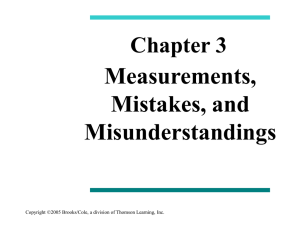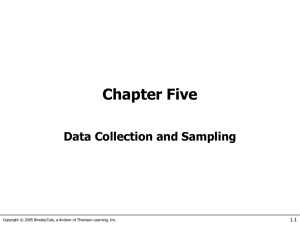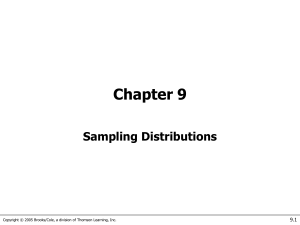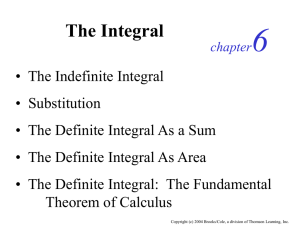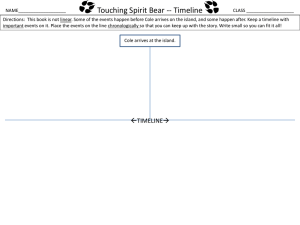statistic
advertisement
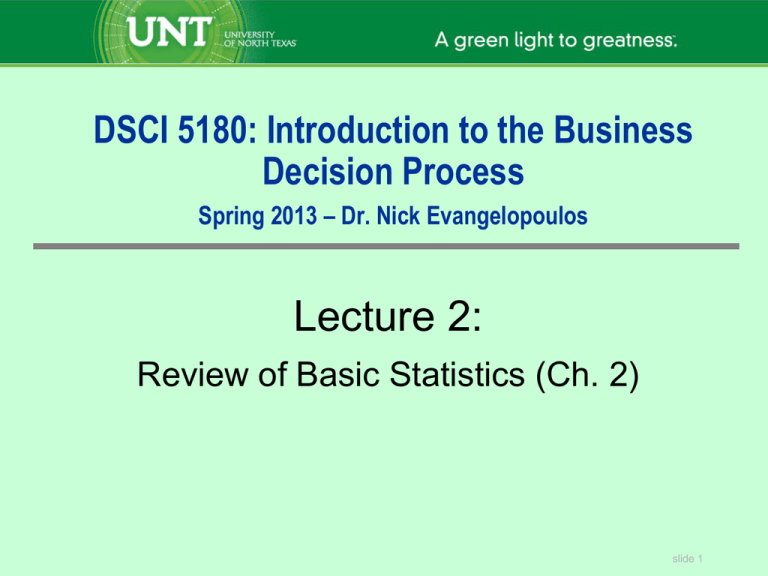
DSCI 5180: Introduction to the Business Decision Process Spring 2013 – Dr. Nick Evangelopoulos Lecture 2: Review of Basic Statistics (Ch. 2) slide 1 DSCI 5180 Decision Making Review of Basic Statistics Statistics show that there are more women in the world than anything else. Except insects. Glenn Ford in Gilda (1946) © Columbia 1946 slide 2 DSCI 5180 Decision Making Review of Basic Statistics If you don’t learn statistics, you will never use it again. If you learn it well, you will use it all the time slide 3 Chapter 2 Review of Basic Statistical Concepts Terry Dielman Applied Regression Analysis: A Second Course in Business and Economic Statistics, fourth edition Statistics Review Copyright © 2005 Brooks/Cole, a division of Thomson Learning, Inc. 4 2.1 Introduction Typically a problem in statistics is one of studying a particular population, perhaps all firms in an industry or the lifetime of a certain brand of tire. In most cases it is not possible to examine the entire population, so we work with a subset of the population called a sample. This study has two phases. In the first, descriptive statistics are used to explore the data. In the second, inferential statistics are used to generalize from the sample to the population. Statistics Review Copyright © 2005 Brooks/Cole, a division of Thomson Learning, Inc. 5 Sampling and Statistics The most common type of sampling is simple random sampling where every item in the population is equally likely to be selected. Any numerical summary from a sample is a statistic and each one has a different sampling distribution that describes its theoretical behavior. This theoretical behavior provides the guidelines for the inference process. Statistics Review Copyright © 2005 Brooks/Cole, a division of Thomson Learning, Inc. 6 2.2 Descriptive Statistics Textbook Table 2.1 shows the 5-year returns as of July 2002 for a random sample of 83 mutual funds. Just looking at a list of numbers like this provides little useful information. The field of descriptive statistics can provide several ways to meaningfully summarize such lists, even when there are far more data. Statistics Review Copyright © 2005 Brooks/Cole, a division of Thomson Learning, Inc. 7 Frequency Distributions The table at right is constructed by breaking the return rates down into 7 categories of equal width. Each data value falls into a unique bin because rates are to nearest .1% 5-year rates of return # of funds -8% to -4.01% 5 -4% to -0.01% 6 0% to 3.99% 17 4% to 7.99% 34 8% to 11.99% 12 12% to 15.99% 8 16% to 19.99% 1 Statistics Review Copyright © 2005 Brooks/Cole, a division of Thomson Learning, Inc. 8 Histograms A graphical method to display a frequency distribution. You can get a quick look of the data's symmetry and spread. 20 Frequency 10 0 -10 0 10 20 5yr ret Statistics Review Copyright © 2005 Brooks/Cole, a division of Thomson Learning, Inc. 9 Numerical Summaries These are single numbers computed from the sample to describe some characteristic of the data set. Measures of location include the mean, median and the first and third quartiles. Measures of spread include the standard deviation, range and midrange. Statistics Review Copyright © 2005 Brooks/Cole, a division of Thomson Learning, Inc. 10 Descriptive Statistics in Minitab Variable 5yr ret N 83 Mean 5.371 Median 5.100 TrMean 5.391 Variable 5yr ret Minimum -7.800 Maximum 17.000 Q1 2.700 Q3 8.900 StDev 5.229 SE Mean 0.574 A boxplot is a good way to display many of the summary stats. 0 10 20 5yr ret Statistics Review Copyright © 2005 Brooks/Cole, a division of Thomson Learning, Inc. 11 2.3 Discrete Random Variables and Probability Distributions A random variable is a rule that assigns a number to every possible outcome of an experiment. A discrete random variable is one with a definite distance between each of its possible values. For example, the number of heads in a single coin toss or the number of kings in two draws from a deck. Statistics Review Copyright © 2005 Brooks/Cole, a division of Thomson Learning, Inc. 12 Probability Distributions In each experiment, the outcome is determined by chance. We can assign probabilities to these outcomes and thus to the values of the random variable. A probability distribution is a list of all the possible values and their associated probabilities. Statistics Review Copyright © 2005 Brooks/Cole, a division of Thomson Learning, Inc. 13 Probability distribution for coin toss Let X = # heads on a single coin toss P(x) = the probability that the random variable X takes on value x x 0 1 P(x) .5 .5 Statistics Review Copyright © 2005 Brooks/Cole, a division of Thomson Learning, Inc. 14 Probability Distribution for 2-card Draw Take Y = # kings in the 2-card draw y 0 1 2 ______P(y)_____ 188/221 = .8507 32/221 = .1448 1/221 = .0045 Statistics Review Copyright © 2005 Brooks/Cole, a division of Thomson Learning, Inc. 15 Where did these come from? With a 52-card deck, there are 52*51 = 2652 possible two card draws. There are 48 cards other than Kings, which is 48*47 = 2256 draws P(0 Kings) = 2256/2652 = 188/221 Statistics Review Copyright © 2005 Brooks/Cole, a division of Thomson Learning, Inc. 16 Laws of Probability There are two conditions that probabilities must satisfy: 1. 0 P(x) 1 2. Sum of all P(x) = 1 This says that each probability must be between 0 and 1, and the total probability in the distribution must add up to 1. Statistics Review Copyright © 2005 Brooks/Cole, a division of Thomson Learning, Inc. 17 Numerical Summaries When we discussed a sample of observations, we discussed certain numerical summaries. The ones most often used were the sample mean and standard deviation. We have similar measures here that describe certain features of the distribution. Statistics Review Copyright © 2005 Brooks/Cole, a division of Thomson Learning, Inc. 18 Profit From Two Investments x P(x) y P(y) -2000 .05 0 .40 -1000 .10 1000 .20 1000 .10 2000 .20 2000 .25 3000 .10 5000 .50 4000 .10 Statistics Review Copyright © 2005 Brooks/Cole, a division of Thomson Learning, Inc. 19 Expected Value The expected value of a discrete random variable is: E( X ) X xP( x) This is a weighted average of the values of X, where the weights are the probabilities. Statistics Review Copyright © 2005 Brooks/Cole, a division of Thomson Learning, Inc. 20 Expected Profit From Two Investments x P(x) xP(x) y P(y) yP(y) -2000 .05 -100 0 .40 0 -1000 .10 -100 1000 .20 200 1000 .10 100 2000 .20 400 2000 .25 500 3000 .10 300 5000 .50 2500 4000 .10 400 E(X)= 2900 E(Y)= 1300 Statistics Review Copyright © 2005 Brooks/Cole, a division of Thomson Learning, Inc. 21 An Interpretation The expected return of investment X is 2900 but this value will never occur. The probability of getting this value is 0, so we can't "expect" it to happen. A better interpretation of this number is that if we could do this investment many times, this would be the average of all those returns. Statistics Review Copyright © 2005 Brooks/Cole, a division of Thomson Learning, Inc. 22 Investment Risk Although X clearly has the higher expected return, note that 15% of the time it loses money. Some people may thus prefer Y because it never loses. The variance of the returns is sometimes used as a measure of risk. Statistics Review Copyright © 2005 Brooks/Cole, a division of Thomson Learning, Inc. 23 Variance The variance of a discrete random variable is: Var( X ) x P( x) 2 2 X Because this is in squared units ($ squared here), we often work with the square root, X. Statistics Review Copyright © 2005 Brooks/Cole, a division of Thomson Learning, Inc. 24 Variance of X x P(x) x-µx (x-µx)2 (x-µx)2P(x) -2000 .05 -4900 24,010,000 1,200,500 -1000 .10 -3900 15,210,000 1,521,000 1000 .10 -1900 3,610,000 361,000 2000 .25 -900 810,000 202,500 5000 .50 2100 4,410,000 2,205,000 X2 = 5,490,000 Statistics Review Copyright © 2005 Brooks/Cole, a division of Thomson Learning, Inc. 25 X Has More Risk calculate that X2 = 5,490,000. A similar calculation for the returns on Y yields Y2 = 1,810,000 so X both returns and varies more. The two standard deviations are X = 2343.07 and Y = 1345.36 We Statistics Review Copyright © 2005 Brooks/Cole, a division of Thomson Learning, Inc. 26 2.4 The Normal Distribution A continuous random variable can take any value over a given range. The most important one is no doubt the normal random variable whose probability distribution is often depicted as bell-shaped. It is centered at µ and most of its probability is within 3 of the mean. Statistics Review Copyright © 2005 Brooks/Cole, a division of Thomson Learning, Inc. 27 ___ Two Normal Distributions: µ = 100, = 10 ---- µ = 100, = 20 Statistics Review Copyright © 2005 Brooks/Cole, a division of Thomson Learning, Inc. 28 Calculating Normal Probabilities For any continuous variable, probabilities are areas under the probability curve. For the normal, these computations have been tabulated (Table B.1). Because each combination of µ and defines a different distribution, the table shows the "standard normal" with mean 0 and standard deviation 1. Statistics Review Copyright © 2005 Brooks/Cole, a division of Thomson Learning, Inc. 29 The Standard Normal Distribution -4 -3 -2 -1 0 1 2 3 4 Units of measurement are standard deviations above/below the mean Statistics Review Copyright © 2005 Brooks/Cole, a division of Thomson Learning, Inc. 30 Standardizing To use the tables with any normallydistributed variable, we convert with the standardizing transformation: Z = ( X - X)/X For example, if X has mean 10 and standard deviation 2: Z = ( X - 10)/2 Statistics Review Copyright © 2005 Brooks/Cole, a division of Thomson Learning, Inc. 31 Reverse Standardizing Sometimes we have the reverse problem, where we know a probability and want to find the X value associated with it. The probability yields the Z-value, then we get X by: X = µX + Z X Statistics Review Copyright © 2005 Brooks/Cole, a division of Thomson Learning, Inc. 32 Example 2.2 A large retail firm has accounts receivable that are assumed to be normal with mean µ = $281 and standard deviation = $35. What proportion of accounts are above $316? Above what value do 13.57% of the accounts lie? Statistics Review Copyright © 2005 Brooks/Cole, a division of Thomson Learning, Inc. 33 Computations for Above 316 Z = ( X - )/ .3413 .1587 = (316 – 281)/35 = 35/35 = 1.00 -4 -3 -2 -1 0 1 2 3 4 281 316 P(Z > 1.00) = .5 - .3413 = .1587 Statistics Review Copyright © 2005 Brooks/Cole, a division of Thomson Learning, Inc. 34 Where are the upper 13.57%? X = + Z .3643 .1357 = 281 + 1.1(35) = 281 + 38.5 -4 -3 -2 -1 0 1 2 3 4 Z = 1.1 = 319.50 Statistics Review Copyright © 2005 Brooks/Cole, a division of Thomson Learning, Inc. 35 2.5 Populations, Samples and Sampling Distributions A statistic uses its own sampling distribution to make inference about the population. For example, y is the statistic most often used to make inference about the population mean µ. The sample mean is a random variable thus follows a probability distribution. Statistics Review Copyright © 2005 Brooks/Cole, a division of Thomson Learning, Inc. 36 The Sampling Distribution of y Assume the random variable Y has mean µ and standard deviation . We observe a random sample of size n on Y and compute the sample average. The expected value of y is µ and the standard deviation of y is: y Y n Statistics Review Copyright © 2005 Brooks/Cole, a division of Thomson Learning, Inc. 37 Distributional Form If the observations come from a normal distribution, the sampling distribution is also normal. The Central Limit Theorem states that the distribution is approximately normal as long as the sample size n is large (usually 30 or more). Statistics Review Copyright © 2005 Brooks/Cole, a division of Thomson Learning, Inc. 38 Example 2.3 In a manufacturing process, the diameter of a certain part averages 40 cm. The variation appears to be normally distributed with standard deviation .2 cm. If a sample of 16 parts is chosen, what is the probability that the average diameter is greater than 40.1 cm? Statistics Review Copyright © 2005 Brooks/Cole, a division of Thomson Learning, Inc. 39 Distribution of average diameter For n=16, the standard error is y Y n 0.2 16 .05 Thus, 40.1 40 P( y 40.1) P Z .05 P( Z 2) .5 .4772 .0228 Statistics Review Copyright © 2005 Brooks/Cole, a division of Thomson Learning, Inc. 40 2.6 Estimating a Population Mean Point estimates are single numbers used as an estimate of a population parameter. In general, these will never be exactly right so we use them as the basis for an interval estimate. Because we base the interval on the sampling distribution, we know the probability content of the interval. Statistics Review Copyright © 2005 Brooks/Cole, a division of Thomson Learning, Inc. 41 The 95% Interval .9500 .025 -4 -3 -2 -1 0 .025 1 -1.96 3 4 1.96 Statistics Review Copyright © 2005 Brooks/Cole, a division of Thomson Learning, Inc. 2 42 The General Interval In general, let denote the total tail probability. A 100(1- )% confidence interval estimate of µ is: , y z / 2 y z / 2 n n where z/2 is the standard normal value that has tail probability /2. Statistics Review Copyright © 2005 Brooks/Cole, a division of Thomson Learning, Inc. 43 Example 2.5 In a department store, the charge account balances of customers has a standard deviation of $35. They will take a sample of 100 accounts and want to make a 90% interval estimate for all accounts. If the sample mean is $245, what is the interval estimate? Statistics Review Copyright © 2005 Brooks/Cole, a division of Thomson Learning, Inc. 44 Interval estimate For a 90% interval, the multiplier is z=1.65. The interval is: , y 1.65 y 1.65 n n 45 45 245 1.65 , 245 1.65 100 100 or 245 ± 7.42 = ($237.58 to $252.42) Statistics Review Copyright © 2005 Brooks/Cole, a division of Thomson Learning, Inc. 45 When Is Unknown The previous result required us to know the population standard deviation . In most cases, this is not known and we estimate it by the sample standard deviation, thus have an estimated standard error: sx Statistics Review Copyright © 2005 Brooks/Cole, a division of Thomson Learning, Inc. s n 46 t Distribution Interval Statistical theory tells us that our interval estimator is now: y t 2 , n 1 where s n t/2,n-1 is a multiplier from the t distribution with n-1 degrees of freedom. Statistics Review Copyright © 2005 Brooks/Cole, a division of Thomson Learning, Inc. 47 Example 2.6 A manufacturer wants to estimate the average life on an expensive electrical component. Because the test destroys the component, a small sample is used. If the test results are 92, 110, 115, 103 and 98, find a 95% interval estimate of the average lifetime. Statistics Review Copyright © 2005 Brooks/Cole, a division of Thomson Learning, Inc. 48 Computations We get y = 103.6 and s = 9.18 For n=5, we use the t distribution with 4 degrees of freedom. The multiplier is t.025,4 = 2.776. The interval is: 103.6 ± 2.776(9.18/√5) 103.6 ± 11.40 92.2 to 115.0 hours Statistics Review Copyright © 2005 Brooks/Cole, a division of Thomson Learning, Inc. 49 2.7 Hypothesis Tests About a Population Mean In the previous section we discussed estimating an unknown parameter. Here we use the sample data to test a preconceived belief about the value of a parameter. We state this belief in a hypothesis, thus the procedure is called hypothesis testing. Statistics Review Copyright © 2005 Brooks/Cole, a division of Thomson Learning, Inc. 50 An Example Is the population average 10? H : 10 (On average, mean is 10) H a : 10 (No it isn't) Statistics Review Copyright © 2005 Brooks/Cole, a division of Thomson Learning, Inc. 51 Notation and Terminology H0 is called the Null Hypothesis Ha is called the Alternative or Research Hypothesis We will set up a decision rule to determine whether we accept or reject the null hypothesis. This rule is constructed after we choose the test's level of significance. A test statistic will be computed from the sample information to make the decision. Statistics Review Copyright © 2005 Brooks/Cole, a division of Thomson Learning, Inc. 52 Level of Significance If we perform the test and the null hypothesis really is correct, there is a chance we will say it is false because we happened to get some fairly extreme values in our sample. We control for this by setting up the decision rule so there is a small probability of this happening. This probability is the level of significance. Statistics Review Copyright © 2005 Brooks/Cole, a division of Thomson Learning, Inc. 53 Continuing Suppose we know that the population standard deviation is 2, and we wish to use a 5% level of significance. H : 10 H a : 10 We will reject H0 if we get either a very large or very small value of the sample average. Statistics Review Copyright © 2005 Brooks/Cole, a division of Thomson Learning, Inc. 54 The Decision Rule for a 5% Level of Significance Reject if sample average < 9.608 or > 10.392 .9500 .025 -4 -3 -2 -1 0 .025 1 -1.96 3 4 1.96 C1 = 9.608 C2 = 10.392 Statistics Review Copyright © 2005 Brooks/Cole, a division of Thomson Learning, Inc. 2 55 Sample Average as Test Statistic In this example we were able to use the sample average as our test statistic (reject if average < 9.608 or > 10.392). Because we knew the standard deviation we were able to figure out what points corresponded to the two z critical values. We could also have worked with a standardized test statistic, which is what we will have to use if is unknown. Statistics Review Copyright © 2005 Brooks/Cole, a division of Thomson Learning, Inc. 56 Standardized Test Statistic We could have worked with: y 0 z n If so, the decision rule is: At a 5% level of significance, reject H0 if z > 1.96 or z < -1.96 Statistics Review Copyright © 2005 Brooks/Cole, a division of Thomson Learning, Inc. 57 Tests When Is Unknown As in the estimation problem, use the sample standard deviation. The standardized test statistic is now: y t 0 s n The critical values now come from the t distribution with n-1 degrees of freedom. Statistics Review Copyright © 2005 Brooks/Cole, a division of Thomson Learning, Inc. 58 Example 2.8 A company that manufactures rulers wants to insure the average length is correct (12 inches). From each production run, a sample of 25 rulers is selected and checked with accurate equipment. One particular sample had an average of 12.02 inches with a standard deviation .02 inch. Using a 1% level of significance, test to see if production is on target. Statistics Review Copyright © 2005 Brooks/Cole, a division of Thomson Learning, Inc. 59 Our example H0: = 12 Ha: 12 (everything OK) (something wrong) y 12 Decision process: compute t s 25 Decision rule: Reject H0 if t > t.005,25 = 2.797 or if t < -2.797 Statistics Review Copyright © 2005 Brooks/Cole, a division of Thomson Learning, Inc. 60 Results The sample averaged 12.02 with a standard deviation of .02. y 12 12.02 12 .02 t 5 s 25 .02 25 .004 Because this is beyond 2.797, we reject H0 and conclude we are producing rulers longer than 12 inches. Statistics Review Copyright © 2005 Brooks/Cole, a division of Thomson Learning, Inc. 61 One-Sided Tests (Lower Tail) H 0 : 0 (or ) H a : 0 Reject H0 if y is too small Statistics Review Copyright © 2005 Brooks/Cole, a division of Thomson Learning, Inc. 62 One-Sided Tests (Upper Tail) H 0 : 0 (or ) H a : 0 This time reject H0 if y is too large Statistics Review Copyright © 2005 Brooks/Cole, a division of Thomson Learning, Inc. 63 P-Value Most software packages report the results of a hypothesis test computing the p-value of the test. This is just a probability that says how far out in the tail the test statistic fell. An equivalent decision rule is this: Reject H0 if the p-value < Statistics Review Copyright © 2005 Brooks/Cole, a division of Thomson Learning, Inc. 64 Example We have a one–sided test: H0: µ 10 Ha: µ > 10 we knew that was 10, sampled n=100 and obtained a sample average of 12, what is the p-value? If Statistics Review Copyright © 2005 Brooks/Cole, a division of Thomson Learning, Inc. 65 P Value • First find the value of the test statistic. P = .0228 12 10 z 2 .0 10 100 -4 • Now find tail probability beyond the computed value. Statistics Review Copyright © 2005 Brooks/Cole, a division of Thomson Learning, Inc. -3 -2 -1 0 1 2 3 4 z = 2.00 66 2.8 Estimating the Difference Between Two Population Means Here we have two samples and two sets of statistics: Sample 1: n1 y1 s1 Sample 2: n2 y2 s2 and want to use them to estimate the difference between the two population means, µ1 and µ2 Statistics Review Copyright © 2005 Brooks/Cole, a division of Thomson Learning, Inc. 67 Estimate and Standard Error A good estimate of the difference in means, (µ1 - µ2) is the difference in sample means, y1 y2 . If we know the standard deviations, the standard error of y1 y2 is: n1 n2 2 1 2 2 Statistics Review Copyright © 2005 Brooks/Cole, a division of Thomson Learning, Inc. 68 Interval Estimate If we are sampling from two normal populations, an interval estimate is: ( y1 y2 ) z 2 n1 n2 2 1 2 2 We can also use this as a good approximate interval if both sample sizes are large (n1 30 and n2 30). Statistics Review Copyright © 2005 Brooks/Cole, a division of Thomson Learning, Inc. 69 Unknown 1 and 2 We can use this formula only if the population standard deviations are known. If they are not, we can use the sample standard deviations and get: 2 1 2 2 S S n1 n2 Statistics Review Copyright © 2005 Brooks/Cole, a division of Thomson Learning, Inc. 70 The Approximate Interval As before, use of the sample standard deviations means we use a t distribution for the multiplier. In this case, the results are only approximate and the t distribution has degrees of freedom (see the text for how is computed.) Statistics Review Copyright © 2005 Brooks/Cole, a division of Thomson Learning, Inc. 71 The Pooled Variance Estimate In some cases, it may be reasonable to assume that 1 and 2 are approximately equal, in which case we need only estimate their common value. For this purpose, we "pool" the two sample variances and get Sp2 which is a weighted average of the two sample variances. Statistics Review Copyright © 2005 Brooks/Cole, a division of Thomson Learning, Inc. 72 The Exact (pooled sample) Interval If this is the situation, we can compute an exact interval: ( y1 y2 ) t 2,n1 n2 2 1 1 S n1 n2 2 p Note that the pooling allows us to combine degrees of freedom: df = (n1-1)+(n2-1) = n1 + n2 -2 Statistics Review Copyright © 2005 Brooks/Cole, a division of Thomson Learning, Inc. 73 What Should We Use? If we know the two population variances are about equal, use the exact procedure. If we think they differ a lot, we should use the approximate result. If we do not really know, the approximate approach is probably best. Statistics Review Copyright © 2005 Brooks/Cole, a division of Thomson Learning, Inc. 74 Example 2.10 For the 83 mutual funds we discussed earlier, we want to compare the five-year returns for load funds versus no-load funds. The Minitab output for both procedures is on the next slide. The exact procedure output is on the lower half. Statistics Review Copyright © 2005 Brooks/Cole, a division of Thomson Learning, Inc. 75 Minitab Two-Sample Output Two-sample T for 5yr ret LoadNoLo 0 1 N 32 51 Mean 5.95 5.01 StDev 5.88 4.80 SE Mean 1.0 0.67 Difference = mu (0) - mu (1) Estimate for difference: 0.94 95% CI for difference: (-1.54, 3.42) T-Test of difference = 0 (vs not =): T-Value = 0.76 Approximate P-Value = 0.450 DF=56 Two-sample T for 5yr ret LoadNoLo 0 1 N 32 51 Mean 5.95 5.01 StDev 5.88 4.80 SE Mean 1.0 0.67 Difference = mu (0) - mu (1) Estimate for difference: 0.94 95% CI for difference: (-1.41, 3.29) T-Test of difference = 0 (vs not =): T-Value = 0.80 Both use Pooled StDev = 5.24 Statistics Review Copyright © 2005 Brooks/Cole, a division of Thomson Learning, Inc. Exact (uses pooled SD) P-Value = 0.428 DF=81 76 Interpretation Since we do not have information that the population variances are equal, it is best to use the approximate procedure. The degrees of freedom are =56 and the interval estimate of (µNoLoad - µLoad) is -1.538 to 3.423. Because this interval contains zero, we can conclude the return rates are not that different. Statistics Review Copyright © 2005 Brooks/Cole, a division of Thomson Learning, Inc. 77 2.9 Hypothesis Tests About the Difference Between Two Population Means Our test is of the form: H0: µ1 = µ2 Ha: µ1 µ2 (No difference) (One is higher) which has an equivalent form: H0: µ1 - µ2 = 0 Ha: µ1 - µ2 0 (Difference is zero) (Difference not zero) Statistics Review Copyright © 2005 Brooks/Cole, a division of Thomson Learning, Inc. 78 Test Statistic For the hypothesis of zero difference, the test statistic is just: y1 y2 t SE The 2 1 standard error (SE) is either: 2 2 S S n1 n2 or 1 1 S n1 n2 2 p Statistics Review Copyright © 2005 Brooks/Cole, a division of Thomson Learning, Inc. 79 Choice of Procedure As before, we use the approximate procedure with degrees of freedom if we cannot assume 1 and 2 are equal to some common value. If that is a reasonable assumption, we compute the pooled standard error and use the exact procedure with (n1+n2-2) degrees of freedom. Statistics Review Copyright © 2005 Brooks/Cole, a division of Thomson Learning, Inc. 80 Example To test the hypothesis that load and no load funds have the same return, we write: H0: µN - µL = 0 Ha: µN - µL 0 We do not know that the variances are equal, so we use the approximate procedure which has = 56 degrees of freedom. Statistics Review Copyright © 2005 Brooks/Cole, a division of Thomson Learning, Inc. 81 Results At a 5% level of significance, Reject H0 if t > t.025,56 1.96** or t < -1.96 Minitab gives us t = 0.76 so we accept H0 and will conclude there is no difference in average return. **The correct value for a t is 2.003. 56 Statistics Review Copyright © 2005 Brooks/Cole, a division of Thomson Learning, Inc. 82
